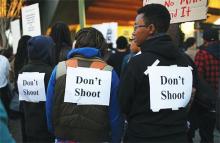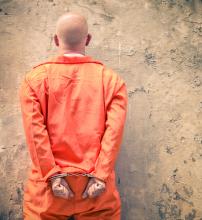Commentary

ON JUNE 2, Environmental Protection Agency administrator Gina McCarthy announced the next phase in the Obama administration’s war on carbon pollution. The Clean Power Plan aims to reduce carbon-dioxide emissions from existing fossil-fuel power plants (the largest source of carbon pollution in the U.S.) 30 percent by 2030. That same day the stock market closed with record highs, and more than 173 companies and investors sent a letter to President Obama in support. Business understands that these regulations are good for long-term economic health.
State governments have welcomed the new plan because while the carbon limits are fixed, the path to achieving them is flexible. It allows both “rate-based” and “mass-based” methods of reduction, something unusual for the EPA, thus allowing some states to target specific industries and others to aim for overall carbon reductions. Catholic social teaching includes the principle of “subsidiarity”—let the most competent authority closest to the problem determine what works best in achieving a common-good goal. The Clean Power Plan that McCarthy, a Catholic, has rolled out does that. Yet it’s not enough and it’s not fast enough to beat our ecological endgame.
President Obama has pledged to reduce U.S. greenhouse gas emissions 17 percent below 2005 levels by 2020. To this end, he has 1) steadily increased car and truck fuel-economy standards; 2) required permits and set strict emission standards on all new fossil-fuel power plants; and 3) taken smaller, interlocking steps, such as establishing wind and solar renewable energy production on public lands, working with China to phase out hydrofluorocarbons, and significantly restricting funding from U.S. foreign aid agencies for new coal plants in other countries. This fall he may launch a low-intensity war on methane pollution from fracking and landfills. It’s not enough. There are too many loopholes.
SIXTY YEARS AGO, Brown vs. Board of Education held that it was unconstitutional to have separate public schools for black and white students. Fifty years ago, a landmark piece of U.S. civil rights legislation was enacted that outlawed discrimination based on race, color, religion, sex, or national origin. By design it was to end, among other important things, educational racial inequities by eliminating separate educational experiences based on race.
Yet today, no matter how we view the data, children of color, especially African-American boys, show unequal levels of achievement—well below their white classmates. Data from the National Association for Educational Progress (NAEP) shows 38 years of limited-to-no change in rates of achievement for African-American and Latino children. Schools across the country are still distinctly segregated by race, and the willful interest and resolve to lead on these issues remains sluggish.
Overcoming systemic racial achievement disparities among children in our public schools is an overarching moral imperative of our day.
How is it that we cannot collectively rupture this trajectory—more than half a century later—“with all deliberate speed”? As an educational leader I find myself focused on these questions: Are those invested in educating our children interested enough? Do we actually know how to educate all students equitably? Where is the resolve among us to make lasting change for all children? I believe that, if we are interested, we’ll learn. And that once we know how, we can change this narrative—but only if we are resolved to insist on positive change no matter the cost.
THE DEEPENING CRISIS gripping Iraq is a clear and present danger to global security. The crisis is fundamentally political in nature, however, not military. It cannot be resolved through the use of force, least of all by external military action from the United States. In the past, U.S. intervention has been the problem in Iraq, not the solution. Indeed many of Iraq’s current problems can be traced to the consequences of the U.S. invasion and occupation.
The United States now has a responsibility to help the Iraqi people, having contributed so much to their current travails, but our involvement should be diplomatic and humanitarian, not military. We should work through the United Nations to exert pressure on the violent extremists who are threatening the region and to mobilize international support for political and diplomatic solutions to the conflicts.
A major center of concern today is the extremist group called the Islamic State of Iraq and Syria, now identifying as the Islamic State. This group led the military takeover of Mosul and other Iraqi cities. It is a direct offshoot of the al Qaeda forces that emerged during the armed resistance to the U.S. invasion, but is now a rival to, and even more extreme than, al Qaeda.
Prior to 2003, al Qaeda did not exist in Iraq. It was only after the U.S. invasion, which shattered the state and sparked widespread violence and insurgency, that Islamist extremist groups were able to gain a foothold in Iraq. American actions fostered staggering levels of corruption and exacerbated growing Sunni-Shia sectarian tensions.

A GROUP of Native Americans appeared before the Trademark Trial and Appeal Board to argue that “Redskins,” the name of Washington, D.C.’s football team, is racist and not deserving of federal trademark protection. Federal law states that a company name may not be “scandalous” or “disparaging.” ...
Offering an opinion is Chief Billy Redwing Tayac of the Piscataway Indian Nation, a Native American people who have been in the Washington area for roughly 10,000 years longer than the football team.

AFRICAN AMERICANS around the country are finding it is dangerous to call 911. Jack Lamar Roberson’s family in Waycross, Ga., discovered this the hard way when they placed an urgent call to 911 in October 2013 because his fiancée thought that he had taken an overdose of diabetes medicine.
Instead of sending EMTs, the dispatcher sent the police. Within 20 seconds of being in the house, police shot Roberson nine times, with bullets striking his back, arms, chest, and head as he held his arms up in the air. Although he was a veteran, he did not die from bullet wounds at the hands of strangers in a foreign land. Instead, white police gunned him down in his home.
Killings like this—which could be called anti-black hate crimes by police—are far too common. “Operation Ghetto Storm,” a 2012 report by the Malcolm X Grassroots Project, revealed that white police officers, security guards, or vigilantes kill an unarmed black man, woman, or child every 28 hours in the U.S. In 2012, police officers shot 57 people in Chicago—50 were black, two were white. Miami police officers killed seven black men within eight months in 2011. The Houston-based African-American News & Issues headlined an article this spring: “Open Season on Blacks in Texas: Cops Are Shooting First & Not Asking Questions.”
These police killings of black people emerge out of a culture and system of white supremacy. In such a context, police killing of black people is not a black problem. It is an American problem that shreds the curtains of democracy.

THE VIOLENCE AND kidnappings in Nigeria are more than a religious conflict: They are a political manipulation of religion.
Before the 2011 Nigerian election, northern politicians (who are mostly Muslims) threatened to make the country ungovernable if Goodluck Jonathan, a Christian from the south, became president. Jonathan was vice-president for Umaru Musa Yar’Adua, a Muslim from the north, who died before completing his eight-year term. Jonathan assumed power after Yar’Adua’s death, as is allowed by the constitution. However, northern Muslims claimed that since Yar’Adua did not finish his term, they should be allowed to place someone of their own choosing in power. Jonathan’s refusal angered the north.
In response, the Muslim terrorist organization Boko Haram began intensifying its attack on Jonathan’s rule in order to discredit his presidency and his pursuit of the 2015 election. If Boko Haram succeeds in pushing Jonathan out, southern militia groups are likely to commence their own violent campaign. These terrorists are trying to manipulate people by making them think that it is a religious fight, when in reality it is about political power.
People, however, are beginning to reject the violence. In April, as the world is well aware, Boko Haram kidnapped more than 200 schoolgirls from Chibok, a community that is said to be about 90 percent Christian. The outcry of rage and pain about this incident transcended religious lines. In a May market bombing in the city of Jos, both Christians and Muslims lost their lives. After the bombings, Muslims and Christians on the streets of Jos tried to work together in finding a way through the situation. People no longer want to fight and are starting to value peacebuilding and interfaith efforts. This is a sign of hope.
FIFTY YEARS AGO, on Aug. 20, 1964, President Lyndon Johnson signed the Economic Opportunity Act into law. It had already been a momentous year. The Civil Rights Act was signed in early July, ending legal segregation. Mississippi Freedom Summer was underway, with hundreds of volunteers joining in voter registration campaigns. The effort to overcome poverty was the next step toward economic empowerment.
The Act created 11 different programs, including the Job Corps, Neighborhood Youth Corps, Volunteers in Service to America (VISTA), and both rural and urban Community Action Programs. Collectively referred to as the “War on Poverty,” the programs were coordinated by the Office of Economic Opportunity. In 1965, Medicaid and Medicare were created to provide health insurance for people in poverty and the elderly, and Title 1 of the Elementary and Secondary Education Act provided funding to school districts with students in poverty. It was the most comprehensive package of social legislation since the New Deal.
Results of the programs have been mixed, with the most striking gains for older Americans. According to a special report from U.S. News & World Report, “While the national poverty rate has ultimately fallen by 4 points since 1964, when the War on Poverty began, from 19.0 in 1964 to 15.0 percent in 2012, the poverty rate for people over 65 has plummeted by more than two-thirds, from 28.5 percent in 1966 to 9.1 percent in 2012.” But with the poverty rate still at 15 percent—46.5 million people in the country currently live below the poverty line—where do we go from here?
We are still in a period of high unemployment, and wage growth is stagnant for many of those who are able to find work. Issues of a living wage, child care, and disintegrating communities continue to need attention. Our economy is rapidly becoming more unequal, with a staggering concentration of wealth held by the very few at the top. All of these factors work against a serious effort to overcome poverty.

MOST discussions about the Bible and homosexuality are limited to a handful of passages and the subject is viewed as a moral issue in which the burden of proof is placed on lesbians and gay men to defend our right to be who we are in light of those passages. If we approach scripture understanding that heterosexism, like sexism and racism, is a justice issue, then we move to a different plane of inquiry.
We might then understand that what is at stake in questions of sexual morality is not sexual orientation per se but rather the rightful or wrongful use of sexuality whatever our orientation. Sexual sins can occur in both heterosexual and homosexual relationships wherever people are exploited, abused, neglected, or treated as objects. On the other hand, love, commitment, tenderness, nurture, respect, and communication can be expressed in both homosexual and heterosexual relationships.

IN 2006, A MAJORITY of Michigan voters amended their state constitution to outlaw the use of race in college admissions. Supporters of affirmative action challenged that amendment in court; in April, the U.S. Supreme Court (in a case known as Schuette vs. Coalition to Defend Affirmative Action) affirmed Michigan’s right to ban the use of affirmative action by public universities.
Justice Sonya Sotomayor issued a 58-page dissent with a blistering critique of the court’s ruling. Sotomayor pointed out the illogic of the majority opinion that the case was about the voters’ right to self-governance. “This case,” she wrote, “is about how the debate over the use of race-sensitive admissions policies may be resolved ... that is, it must be resolved in constitutionally permissible ways.”
Sotomayor explained in her dissent that “by permitting a majority of the voters in Michigan to do what our Constitution forbids, the Court ends the debate over race-sensitive admissions policies in Michigan in a manner that contravenes constitutional protections long recognized in our precedents.” In other words, if we allow the majority to rule without limits, then affirmative action is effectively dead.

THE SHOOTINGS THAT took three lives this spring at a Jewish community center and retirement complex in Kansas are a reminder that deadly strains of what is usually called “anti-Semitism” remain with us. The fact that the shooter was a deranged white supremacist should not prevent us from coming to terms with the roots and survival of Jew-hatred in our culture.
Anti-Semitism is a made-up word that itself gives clues to the history of Jew-hatred in our civilization. The term was coined by German journalist Wilhelm Marr in 1879, one of a number of Jew-haters who were turning longstanding European Christian hatred of Jews into something modern and racial. The “Jewish problem,” therefore, became the “fact” that there was a racial group, the “Semites,” who were a mortal threat to another racial group, the “Aryans,” and therefore needed to be removed from Aryan societies. All right-thinking Germans/Europeans/Aryans, the argument went, needed to unite to combat the Semites through a scientific antisemitismus. The term is usually written “anti-Semitism” in English, but that usage profoundly reinforces the racist myth that there is a race of “Semites” needing to be opposed by “anti-Semites.” The term Jew-hatred is better because it refuses to participate in this mythology.
Modern racialized Jew-hatred flowed into the 20th century and crystallized most disastrously in Nazi Germany. There, over 12 terrible years, the 19th century anti-Jewish program was enacted, and then exceeded. Jews were to be “eliminated” from among the “Aryans,” a program that became annihilation after 1939, with 6 million Jews murdered.

THE PHRASE “POVERTY in America” still conjures up, for many of us, images of a homeless person begging on an urban street corner or a dilapidated shack in rural Appalachia. But a report this winter presents a very different picture of poverty in the U.S.: “a working mother dashing around getting ready in the morning, brushing her kid’s hair with one hand, and doling out medication to her own aging mother with the other.”
The study released in January by The Shriver Report, “A Woman’s Nation Pushes Back from the Brink,” examined the rates of financial insecurity among U.S. women. The report notes that the average woman is paid 77 cents for every dollar the average man earns, and that closing this wage gap would cut the poverty rate in half for working women and their families.
A few years ago, I was at a global women’s conference looking at the economic dimensions of women’s realities when I first heard the phrase “time poverty,” in an academic talk given by a sociologist. The phrase captured the deeply insidious economic realities that are holding back women’s equality. Most mothers know this reality as we multi-task through our day trying to hold life together for our families. Women everywhere carry the double burden of working outside the home to support their families while still doing the large majority of unpaid domestic work.
The phrase “time poverty” stuck with me and, strangely, captures my reality as a mother of three leading a relatively privileged life. For those of us in the mothering season of life, all over the world, time is not exactly on our side. From sunup to sunset, we find ourselves constantly multitasking, moving as fast as possible and feeling like the hub in the middle of everyone’s wheel. Any tiny setback—a lost pacifier, a sick child—can threaten the whole highly tenuous ecosystem of the day.

AS CHRISTIANS, we affirm that God, whose presence fills every nook and cranny of the universe, is already at work in each of our neighborhoods. Even though we can’t see God, God is there, standing at the right hand of the needy (Psalm 109:31). God is hard at work rescuing the oppressed (Jeremiah 20:13), comforting the stranger (Exodus 22:21), pleading the cause of the poor (Proverbs 22:23), giving food to the hungry (Psalm 146:7), giving the desolate a home to dwell in (Psalm 68:6). God’s son Jesus is so totally identified with our neighbors who are ill-clothed, lonely, sick, or imprisoned, that when we minister to them we minister to him (Matthew 25:31-46).
Because the God of biblical faith acts in this way, we can say much about God’s will for our neighborhoods. As a loving parent, God cares deeply about all our neighbors, and wants all God’s children to be free from exploitation and to have what they need for their physical, intellectual, emotional, and spiritual well-being. God’s will is shalom for all.

RECENT YEARS HAVE witnessed a deluge of headlines such as “Jobs Become More Elusive for Recent College Grads” from Reuters and “For Recent College Grads, Recessions Equal Underemployment” from Inside Higher Ed—headlines that make even the most hearty college students experience heart palpitations. According to a 2014 analysis by the Federal Reserve Bank of New York, “the underemployment rate for 22-year-olds is about 56 percent, indicating that more than half of the people just graduating end up working in jobs that do not require a degree,” jobs for which they are overqualified.
To put this into perspective: I am a 22-year-old senior at a private Christian university. Of my close friends who graduated in the last year or two, the only ones who were able to find jobs in their fields were education and nursing majors.
Don’t get me wrong, I love liberal arts and feel grateful for the critical thinking skills, study-abroad opportunities, and philosophical discussions that attending a liberal arts school has afforded me. But learning in the same analysis that “only 40-to-45 percent of recent college graduates majoring in communications, liberal arts, business, and social sciences were working in jobs that required a degree” is troubling at best.
In addition, seven out of 10 college seniors are graduating with an average of $29,400 in debt due to rising tuition costs for an undergraduate education. The National Center for Labor Statistics found that in the past decade, the cost of “tuition, room, and board at public institutions rose 42 percent after adjustment for inflation.” The situation was a bit (though not much) better at colleges in the private not-for-profit group, like my own, where the average price rise was 31 percent.
IN ITS SEEMINGLY endless quest to attack the few remaining pillars of our campaign finance laws, the Supreme Court issued a brazen ruling in McCutcheon vs. FEC, striking down the aggregate contribution limits that capped the overall amount individuals could give to candidates and political parties each election cycle. As it was with Citizens United—the 2010 decision that said corporations and unions could spend unlimited amounts—the court’s April ruling was striking not only in its naiveté about the effect of money in politics, but in its naiveté about the nature of the American experiment itself.
Whereas Citizens United focused on the nature of corporate spending in elections, this decision cuts straight to the chase. Should wealthy people have a greater ability to fund political parties and candidates—and benefit from the greater access and influence that awards them? The court sent a clear message about where it stands: Yes, they should. Chief Justice John Roberts, writing for the majority, even cloaked the decision in pious language, stating, “if the First Amendment protects flag burning, funeral protests, and Nazi parades ... it surely protects political campaign speech despite popular opposition.”
Traditionally the court has asserted that the government has an interest in preventing corruption and the appearance of corruption, the latter in order to sustain public faith in the democratic process. However, the McCutcheon decision defines “corruption” so narrowly that the original statute is essentially useless. The government can no longer prevent the appearance of corruption, and it would have a difficult time proving “quid-pro-quo corruption” occurred in the first place
But despite this disheartening fact, there’s a glimmer of hope. One of the unintended effects of Citizens United was that it created a major “teachable moment” for the public about campaign finance—an issue that had previously gained little attention and was easily misunderstood.

IN THE EARLY evening of Nov. 8, 2013, Arnel Montero convinced his mother, wife, and three children to evacuate to a two-story concrete house above the coastal area of Barangay 70, a fishing village in Tacloban City, on the island of Leyte in Central Philippines. He expected the worst, with the news reporting the arrival of super-typhoon Haiyan the following morning, and thought the house would be a safe place where his family could take shelter while he remained in their shanty by the coast.
Even though Haiyan’s fury hit the islands at speeds surpassing 200 miles per hour, the strong winds alone would not have created such a major tragedy. But Haiyan precipitated a storm surge that led to grave loss of life and massive devastation. Barangay 70 is located near the city’s main pier, and the tidal waters pushed cargo boats toward the coast, smashing shanties and buildings, including the concrete house where Arnel’s family sought shelter. Arnel managed to save himself, but the rest of his family perished.
The National Disaster Risk Reduction and Management Council, as of mid-March 2014, reported 6,268 deaths, although the actual number could be double that. In Barangay 70 alone, there were close to 300 people who died. An estimated 12.2 million Filipinos were affected by the disaster that hit eight provinces in the Visayas islands region; close to 2 million houses were either washed out or partially destroyed.
The national and local government’s response to the massive need for relief operations was slow. Political bickering, incompetent local governments, and the sheer inefficiency of the administration of President Benigno Aquino all contributed to major delays in bringing food, potable water, clothing, medicine, and temporary shelter to the survivors. Weeks after Haiyan struck, interior villages still had not received aid. It was not until early January 2014 that government relief agencies managed to set up the systematic distribution of relief goods.

TO PEOPLE interested in establishing a new community I would encourage them to see 1) who the leaders are, 2) what the purpose of the community is, and 3) what the commitment among them is. Many attempts at community fail because the reasons for living together are vague or “romantic.” I believe that where God’s people are gathered because that has been his word to them, there is a solid foundation on which to build.
Initially, most communities seem to face the same basic problems and struggles, ranging from eating habits to family life to priorities. When people come together committed to share openly, all of who they are eventually emerges. This, in turn, presents areas in the common life (like the ones mentioned above) that must be resolved.

THE TRANS-PACIFIC Partnership may be the largest free trade agreement you’ve never heard of. Or if you have heard of the TPP, it’s likely due to media reports about efforts by President Obama to fast-track the agreement through legislative hurdles. Still, details of the agreement and its secret negotiation process are sparse. Were it not for released drafts of the document and sub-chapters made available by the whistle-blowing site WikiLeaks, it is likely the general public would know little to nothing of the accord.
Building on the foundation of a 2006 economic partnership agreement adopted to encourage trade between Brunei, Chile, New Zealand, and Singapore, the TPP’s expansion of the agreement grows the number of participant nations to 12, adding Australia, Canada, Japan, Malaysia, Mexico, Peru, Vietnam, and the United States. The combined economic force of these nations would dominate global trade, representing roughly $28 trillion—nearly 40 percent—of the world’s gross domestic product.
But the magnitude of this trading pool isn’t what concerns most critics of the TPP. What is more troubling to labor, environmental, and health groups are the powers seemingly granted to multinational corporations by the agreement and the unilateral easing of climate change laws that serve to restrain industrial nations from disproportionate consumption and pollution.
Expanded corporate powers are nothing new for international trade agreements. The North American Free Trade Agreement (NAFTA) gave rise to a legal quagmire that has allowed Exxon Mobil to challenge Canadian offshore drilling regulations, Dow Chemical to bypass local guidelines to expand pesticide production and waste disposal in Mexico, and Eli Lilly to enforce U.S.-issued drug patents and prices outside the country. Previously, under World Trade Organization treaty guidelines, a corporate entity needed to persuade its host country to challenge the trade laws of another. Corporations could not directly litigate against a sovereign nation or its policies.

I WORK ON the frontlines of the movement to end the death penalty in the United States. I grew up in a conservative evangelical home and my faith has led me to this work. In 2008, I had the opportunity to hear stories from murder victims’ family members, death row exonorees, and corrections officials who participated in executions—all of whom believe the death penalty should be abolished. At that point I felt called to do this work and to begin engaging with other evangelicals.
I will confess, it was a lonely job when I started. I wondered who else would join me. So you can imagine my excitement at seeing what has today become a nationwide chorus of Christian voices questioning capital punishment.
A recent poll by the Barna Group showed a majority of Christians in the United States now oppose capital punishment and that young Christians oppose it by a large majority. More than two dozen evangelical leaders from around the country and across the political spectrum recently made their voices heard by publicly requesting a new sentencing hearing, free of racial bias, for a Texas death row inmate. Even conservative political leaders are speaking out against the death penalty.
As one who has been in the trenches on this issue for years, I can confirm that Christian engagement is helping to transform the death penalty debate, and I can tell you that it is being driven by the same forces that moved me—faith and cold, hard facts.

DEALING WITH IRAN is complex for many reasons. This is not a made-up country whose borders were dictated by politicians in the last century; it is Persia—the great empire that fought with Greece before the beginning of the Christian era, the Asiatic power that imperial Rome was never totally able to subdue. From that long history emerged a people with a deep sense of proud history and a realization of national sovereignty that helps guide the destiny of the nation and its peoples.
I recall a conversation years ago with then-Iranian President Mohammad Khatami about nuclear power. He was not in favor of creating weapons of mass destruction, but he clearly promoted Iran’s right to develop nuclear energy for peaceful purposes. To deny this right is an affront to national sovereignty, he argued.
After the unfortunate history of the past government, once again Iran is governed by a president and a cabinet that call for peaceful nuclear development and for a new and more open relationship with the West. This is the fact that has emerged into a clear interim agreement between the so-called P5+1—the members of the U.N. Security Council plus Germany—and Iran. As reported, the goal of ongoing negotiations is to open the door to a 24/7 inspection of nuclear facilities and other guarantees to ensure that Iran will not make nuclear weapons.
The fact that the new president and his foreign minister are talking with the United Nations, and with Western leaders in particular, gives the world a better check on the nuclear ambitions of Iran than we have on any other nation in the region that stretches from the Mediterranean to the Indian Ocean. If in the terrible, and most unlikely, event that a government of Iran should change its position and decide to build a nuclear weapon, the world would know almost immediately because of the security and surveillance that are likely to be part of a permanent agreement. In such an eventuality, it would be possible to reinstitute the former sanctions or even impose more stringent ones.

VIOLENCE is the ethos of our times. It is the spirituality of the modern world. What is generally overlooked is that violence is accorded the status of a religion, demanding from its devotees an absolute obedience-unto-death.
Its followers are not aware that the devotion they pay to violence is a form of religious piety, however. Violence is so successful as a myth precisely because it does not appear to be mythic in the least. Violence simply appears to be the nature of things. It is what works. It seems inevitable, the last and, often, the first resort in conflicts. It is embraced with equal alacrity by people on the Left and the Right, by religious liberals as well as religious conservatives.